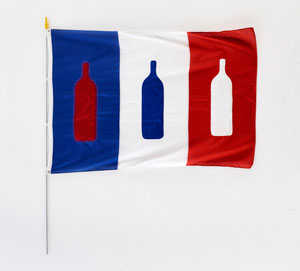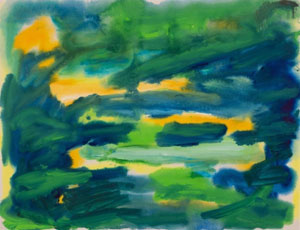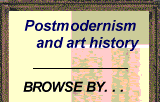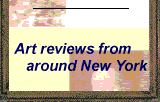A Summer Abroad
John Haberin New York City
Americans in Paris, Asian-American Abstraction, and Beauford Delaney
An American in Paris, was not, as the saying goes, based on a true story. It does, though, come close to the stories of dozens of artists after World War II—the stories of "Americans in Paris," at NYU's Grey Art Museum. It is just one of two summer group shows to take American abstraction overseas and back, but first a trip to Paris.
William N. Copley was not the sort to break into dance like Gene Kelly as an aspiring artist in the movie, but he was plainly enjoying himself. He adds a distinctly American touch to the French flag, with the silhouette of a bottle on each color field in a further permutation of the good old red, white and blue. It suited a city in which a starving artist could afford dinner and drinks in cafés, with or without Jean-Paul Sartre and Simone de Beauvoir. One could rent a hotel room on the cheap as well, although with water for that bottle down the hall or in a public shower.  Copley did not yet have his familiar cartoon style, but he was already playing with outlines and stereotypes. And others, too, were taking in French art while leaving it behind.
Copley did not yet have his familiar cartoon style, but he was already playing with outlines and stereotypes. And others, too, were taking in French art while leaving it behind.
Not all the artists in "Asian-American Abstraction" are Asian-American, but no matter. Who can tell the difference anyway? Think I'm joking? The gallery asks just that, with here, too, the stress on Abstract Expressionism. Wall text roughly midway through, poses the question, and not even a checklist of works stops to answer. Take as long as you like with a challenging summer group show.
In 1953, when so many Americans completed their artistic education in Paris, and so many European refugees powered a new art in America, Beauford Delaney left New York for Europe. He had spent a life in motion, the perpetual outsider, but somehow it always kept him near the center of the action. It had him, too, perpetually struggling for recognition and simply to survive. When he received an urging from James Baldwin to join the writer in Paris, he welcomed it, and he never turned his back. Not that the black artist's emotional and financial struggle got any easier, not even when he discovered postwar abstract art. Yet he was, says the Drawing Center, all along "In the Medium of Life."
He had been through enough as it was. Born in 1901 in the Jim Crow South, he left Tennessee for art school in Boston, and he never entirely outgrew the past. He could literally not afford to do so. In New York since 1929, he made a living from portraits, on commission. It left him broke, but proud enough to turn his skills to those he knew best, including himself. An opening self-portrait shows him with a fleshy face and a cigarette, in early modern color, in a white work shirt. He was suspended between art's past, present, and future.
The old song and dance
Artists might stay in Paris after the fighting, for who could leave the city altogether behind? Or they might return on the GI bill, which paid for studies abroad (and Fernand Léger himself was giving lessons). They might feel themselves in a tradition of Americans in Paris, like Mary Cassatt in pursuit of a singularly American Impressionism or Gertrude Stein and her circle, at the very heart of modern art. Where a year in Paris was once a demand on any artist, now it meant taking chances on yourself and whom you might become. Who needed music by George Gershwin when Americans were, increasingly, the stars. In truth, the "school of Paris" was past its prime in 1951, the year of the film, but "Americans in Paris" has ten more years to come, closer and closer to the postwar art you know.
The large show reverses the conventional picture. You may think first of Europeans fleeing to America for their careers, like Hans Hoffman, or their very lives, like Arshile Gorky. You may think of French art then as an increasingly watered-down Surrealism—the kind that Americans like Jackson Pollock back in New York had to outgrow. You may think of other Americans working their way through a dark prewar realism, like Adolph Gottlieb in still life or Mark Rothko in New York subways. The Grey Museum has little other than abstraction, in coarse metal and painting. This could be Abstract Expressionism and then Minimalism by another name.
To be sure, Americans had a lot to learn. The show opens in the late 1940s with Kenneth Noland, with not a hint of his targets. He embeds cryptic symbols in black. Al Held has an almost uniform blackness, with thick, heavy brushstrokes far from the deep space of his wilder geometry. Nancy Spero paints darkly, too, and with an uncharacteristic tenderness—unless, that is, her Lovers is a rape scene. In no time, though, she is as confrontational as ever, with foul language in paint in French and English.
If they had a lot to learn, they had to learn it from each other or on their own. Many an artist heads to Paris for its museums, but quotations here are few and far between. The show does have a "salon" for what they might have seen in galleries and studios. It looks overly busy and largely irrelevant. Finer artists had at least an eye on the United States, where the action had begun. They lived in Paris, after all, not under a rock.
This could almost be a survey of postwar American art apart from Pop Art. Fluid colors in a shifting field of red, from Ed Clark, approach Gorky. Sam Francis and Claire Falkenstein leave plenty of room for brushwork on a field of white, like color-field painting for Noland or Joan Mitchell. Sure enough, Mitchell turns up as well. Others, too, had the germ of their art from the beginning, like comic-strip figures for Peter Saul, irony for William N. Copley, or a spare geometry for Carmen Herrera. Her red stripe across the bottom of a painting both anchors it and makes it pop.
They work big, and they push toward the edge of the canvas. William Klein, better known for urban photography, lends shadows to geometry, while thin white triangles cut across like arrows. Ellsworth Kelly spans more than one panel, although not yet shaped canvas. His curved green on white looks ahead to later work as well. By the show's end, the school of Paris had few lessons left to give. It was not the first time that Europe had something to learn from visitors from the United States.
Passing the test
Nearly fifty artists, past and present, fill both floors of the gallery for "Asian-American Abstraction" and who are they anyway? They show the influence of East Asian tradition, but also Abstract Expressionism—and there, too, you may have trouble untangling the threads. Don Ahn, for one, works with an eye to calligraphy, but with ink spatters as well. He may have you marveling at the sheer control of Chinese "Companions in Solitude" before him and, in a very different way, drip painting from Jackson Pollock. And then a second work adds a glowing yellow that not even Pollock could know. Ming Wang has her own descending black brush, but also an accordion book of pages twice "letter" size, to accommodate so much more.
Influence here runs every which way—all the more so in a room that includes Abstract Expressionists, too. It also bears text with that stubborn question. Franz Kline has his seeming calligraphy, but then so does Robert Rauschenberg in characters of his own invention. Black for Sheila Isham spirals down a red canvas as Song of the Palace, while Michael West is Drunk with Turpentine. Vivian Springford, like West (surprise!) a long-neglected woman artist, applies acrylic stains in near concentric circles. You may think of Georgia O'Keeffe or Morris Louis, but she had her first solo show in Tokyo, and she credits the influence of Walasse Ting, from Shanghai on his way to America.
If those artists looked to Chinese art, Chinese Americans had their versions of modern art as well. Ivy Wu brings almost Pop Art colors and well-defined geometry to her calligraphy, while Oonju Chan paints on open fields out of Joan Mitchell. Think, then, that you really cannot know the difference? Think again. Just to describe them is to see them as individuals. Those without a signature style can get lost along the way.
Abstract Expressionists relied heavily on their signature, like Kline's monumental characters. Gottlieb has one of his characteristic explosions, of one symbol atop another. Sam Francis has his splotches of red, yellow, and black. They are easy enough to recognize even in relatively small works on paper. Chinese Americans, by comparison, can be more intricate or more fluid. You just might pass that test after all.
Nor does it really come down to Asia and America. Postwar American artists had many influences and many that they influenced. Were they formal or gestural? Were they the heirs to Cubism, Surrealism, or something else again? Where they as American as the Hudson River School, which they admired as well? More and more, too, curators are looking beyond Abstract Expressionist New York to a global movement. Asians, say, had their share starting in 1954, in Gutai.
The question still matters, and it sets this show apart. It asks one to look beyond major works and heavy hitters. It asks, too, to well-known artists as infinitely changeable. Who would have thought of Rauschenberg as an abstract painter? He rejected all that, right? You might have to read his indecipherable letters to find out.
Outside looking in
The young Beauford Delaney leaned to profiles, including a charcoal of an athlete in the illusion of the embossed image on a coin. Friends appear looser and more accomplished, and he had a gift for hooking up. He sketched leading black artists like himself, including Norman Lewis, Jacob Lawrence, and Romare Bearden, but also Alfred Stieglitz, Georgia O'Keeffe, and, in prose, Henry Miller. It did not make the struggle any easier. He mingled with the Harlem Renaissance but lived on the southern fringe of the West Village. He seemed to delight equally in being accepted and ignored. 
The Drawing Center sets off a room for documentation. It includes a note from Al Hirschfeld, who became popular in the entertainment world. The cartoonist does not sound like it here: tried and tried with no success. He could be speaking for Delaney. Still, the African American keeps turning up in all the right places.
He is in Yaddo, the artistic colony, and on Greene Street, in today's Soho, checking out the traffic lights. He adopts fields of opaque color central to art from Stuart Davis to Pop Art. Yet he must have been looking by now not so much for success as for pure escape. He must have envied Baldwin's ability to make a sensation. He must have identified with Baldwin as a gay male as well. They had been in touch ever since 1945.
Delaney did not remain altogether an outsider, serving as a professor in Paris. Just as important, there he adopted black abstraction. He approaches monochrome, in dabs of intense color though with one or more more peeking through—only one thing. He still makes portraits, especially self-portraits. There, too, he stays constant in his jowly features and sharp color, in pastel, watercolor, and gouache. He might have become two artists, competing to define African American art.
Far from New York, he explores African American identity as well. He experiments with mud color and red on bark. He studies African figuration. The more he turns to himself, the more, too, he approaches cartoons. He is still looking to what he had learned from Hirschfeld, but also from modern art. Just try to separate the impulses.
He was not altogether a failure, and he knew it. Someone flouting convention like Miller admired him no end. The survey gets the entire Drawing Center, including the back room and the basement lab. With today's erosion of the separation between representation and abstraction, he has a new claim to relevance as well. His depression, though, only deepened after the death of Martin Luther King, Jr., and at his death in 1979 he was still on the outside looking in. Maybe that is the place to be.

"Americans in Paris" ran at NYU's Grey Art Museum through July 20, 2024, "Asian-American Abstraction" at Hollis Taggart, through September 7. Beauford Delaney ran at the Drawing Center through September 14, 2025.




